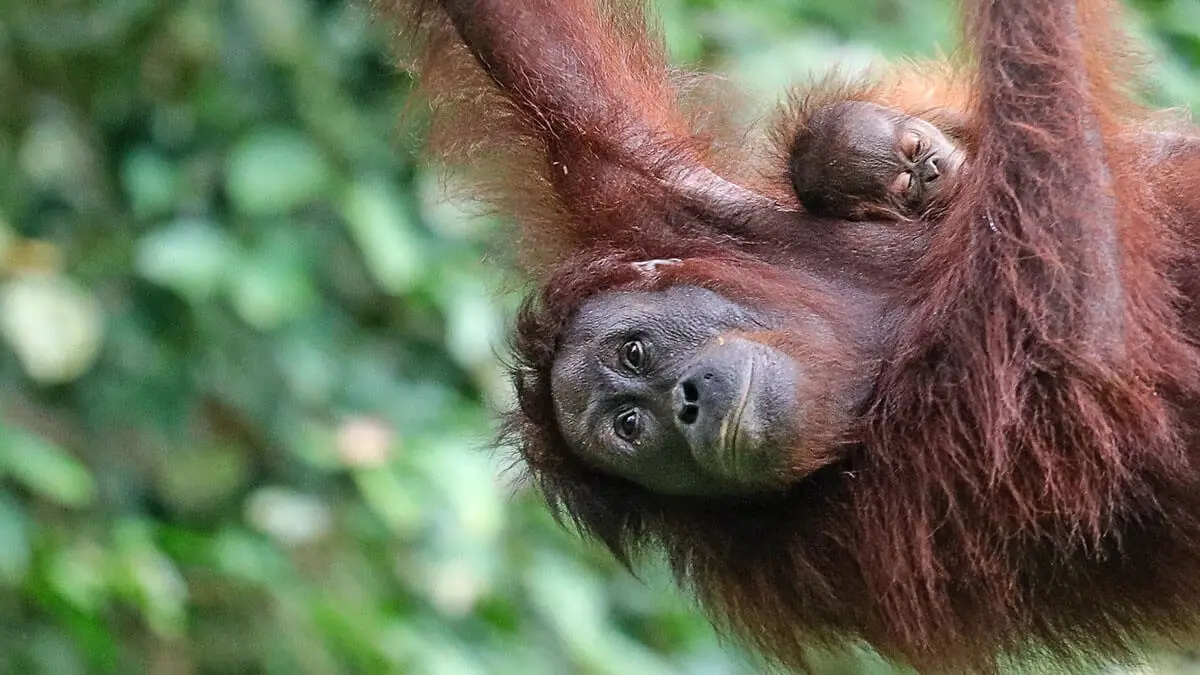Indonesia and Malaysia are becoming increasingly popular with visitors who wish to see orangutans in their natural habitat. Many travelers also seek experiences at rescue centers or sanctuaries that allow them to visit or participate in longer-term volunteer programs. To ensure that you make informed and ethical travel decisions in these situations, it is important to become aware of the considerations to make before visiting an operation.
Orangutans are a critically endangered species, facing daily threats from deforestation. They are often rescued in grave condition and in need of rehabilitation and rehoming. Rescue centers play a critical role in orangutan conservation, with the goal of treating injured animals and releasing them to safer forest ranges. Some centers offer educational tours so visitors can learn more about the orangutan’s plight and the cost of deforestation. Others may be closed to the public but may offer volunteer opportunities.
You can help protect these animals during your travels by supporting responsible operations and identifying attractions to avoid. Since the terms ‘conservation’ and ‘rehabilitation’ can be used freely by businesses, it is important to know what to look out for as you review various facilities. The guidelines below provide a list of the main questions to consider before patronizing an operation – whether for an afternoon, a day or a weeks-long volunteer trip.
Guidelines for Captive Orangutans in Sanctuaries, Rescue and Volunteer Programs
- If possible, use a responsible tour operator. Responsible operators will vet a facility or program before offering it to their clientele. Look for companies that have made commitments to not offer exploitative tours and to evaluate an operation before partnering with them.
- Research as much as you can beforehand. Look for reviews and word-of-mouth tips. Travelers provide useful details about attractions, and often it is enough information from which you can evaluate ethics based on these guidelines. Contact orangutan conservation organizations, some of which are provided below, and ask them for input on a specific attraction or program.
- Watch out for operations that offer and actively promote direct animal interaction or feeding. Reputable organizations will allow viewing and educational tours but never handling, feeding and interaction between daily visitors and the animals, particularly for photo opportunities. Handling of wild animals causes them stress, poses health risks by potentially exposing them to human viruses, and affects their ability to be successfully reintroduced to the wild. Some handling exceptions include rescue centers that specifically seek skilled veterinary or screened volunteers with the right experience to assist with critically ill orangutans that are starved, abused or in shock after losing their forest home. Another exception may be when volunteers are assisting staff with enrichment activities that may include providing food or toys.
- Thoroughly wash your hands before entering orangutan areas at a sanctuary. Illness and germs can be easily transmitted from humans to orangutans. Maintaining clean hands is the primary way you can prevent this from happening.
- No orangutan breeding should be allowed at the operation. Breeding captive animals that will not be introduced to the wild is usually a sign that the practice is being done for profit.
- The sanctuary’s goal should be to release orangutans back into the wild. Reputable centers will work toward the ultimate goal of rehabilitating orangutans to be released back into their wild habitat.
- Sanctuary tours should have a group maximum. Tour groups should be limited to 12-15 people at the most, so as not to overwhelm the orangutan sanctuary environment.
- Orangutans should not be exploited for tourism purposes. If you see a sanctuary that displays the animals in an exploitative way, engaging in tricks or unnatural behavior for the profit of the operation, this is a significant red flag that animal welfare is not of paramount concern.
- Review volunteer duties and inquire about the curriculum before you book. Reputable programs will thoroughly vet their volunteer candidates to ensure they are capable of working in the sanctuary environment. Volunteer duties should support the operation and may entail constructing enclosures, assisting with habitat maintenance, providing enrichment toys or food to orangutans, or supporting administrative duties. Regardless of the volunteer’s role, reputable centers will stress that each responsibility plays an important part in the orangutan’s recovery as the operation is able to manage priorities and focus on crucial needs.
- Find out the origins of the orangutans and their rescue story. Sanctuaries should offer a comprehensive background on each orangutan’s rescue story. If a facility is not transparent about the origins of their residents, some may have been taken from the wild for profit.
- Pay attention to the sanctuary environment: The sanctuary should provide adequate temporary housing and a forested environment where rehabilitating orangutans can be released during the day. Rehabilitating orangutans require housing for their own safety, and an area that is as close as possible to their natural habitat. To encourage natural behaviors, the sanctuary should also incorporate enrichment that stimulates the orangutans both physically and mentally. This may include providing toys or treats; however, the types of enrichment can vary depending on veterinary recommendations.
Additional Resources on Orangutan Conservation
- Borneo Orangutan Survival Foundation
- Gunung Palung Orangutan Conservation Program
- HUTAN – Kinabatangan Orang-utan Conservation Programme
- International Animal Rescue | Borneo Orangutan Rescue
- Orangutan Appeal UK
- Orangutan Foundation International
- Orangutan Foundation UK
- Sumatran Orangutan Conservation Program
This article has been endorsed by Dr. Birute Galdikas and Orangutan Foundation International.
Free Sustainable Travel Tips List


 Written By:
Written By: 


